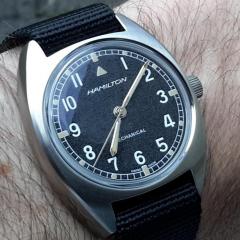-
Recently Browsing
- No registered users viewing this page.
-
Topics
-
Posts
-
By nevenbekriev · Posted
Rich, this one seems rather regular movement to me. Yes, what You describe exists, but I doubt that the one on the picture is something similar. -
@Neverenoughwatches Many thanks for your remarks. As I wrote earlier, I was a bit reluctant to disassemble this movement, and you gave me further motives to be careful. I'll just remove it from its case so as to clean it a little.
-
By nevenbekriev · Posted
I am not sure for the terms in english, but if I directly translate from Bulgarian or Russian, there are 'magnetic soft' and 'magnetic hard' magnetic materials. The first group will not get magnetised, thow they will be attracted by magnets. The soft iron for example. The second group, like hardened steel, will get magnetised. So non magnetic hairspring aloys belong to the first group. -
By nevenbekriev · Posted
Looks like it is only dirt. If rust, then this means the strenght of the spring is reduced in places with rust, so the spring is damaged and useless. Only light surface rust, which is rather residual from other places activity of rust can be cleaned, and no chemicals that can etch the metals of the spring aloy should be used -
Hello, I'm after some help on getting a functional tool for removing and replacing case tubes, the friction fit type not the threaded type. I have previously owned two Chinese Ali Express tools, which worked, but in each case after using on a watch case with an angle the watch had to be manually held perpendicular and when this angle was not perfectly aligned the pusher pin inevitably received a slight side load and the tool body was damaged. Due to the fact that the hole which holds the pusher pin is so close to the end of the block and the material wall is so thin: The result was that the hard pusher pin stretched and deformed the hole and the pusher pin was then slack and no longer perpendicular, and eventually the material split altogether. After I looked at the tool I realised that the block the hole was machined into was aluminum, this coupled with the extremely thin wall made this hole very weak and prone to the deformation and damage I had experienced. I looked to another reputable supplier (see below) who advertised their tool as "all steel" and I even contacted their customer support who confirmed that the block in question was made of steel. I was very disappointed yesterday when it arrived and found that it was in fact aluminum and not steel as promised. I could tell by the feel of the material (weight) and confirmed with a magnet which would not 'stick' and have since requested a return/refund. Assuming the return/refund goes smoothly, I am still left with my original problem of not having a tube pusher tool - does anyone have any recommendation for a tool which will work and will also stand the test of time?
-







Recommended Posts